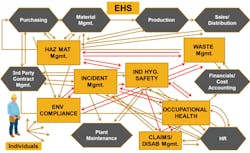Sustainable Safety Management: Incident Management as a Cornerstone for a Successful Safety Culture
Most people are aware of the major incidents that have happened in the last years – ones with grave environmental consequences and worker fatalities. The Deepwater Horizon oil rig catastrophe is just one prominent example. Despite these major incidents that receive a lot of publicity, incident numbers in general are much diminished, but it also seems that on this diminished level, they have reached a kind of low barrier that industries cannot drop below.
Safety regulations and safety management have decreased the number of workplace safety and environmental incidents in many industries, and personal protective equipment and safety measures have reduced the impact of accidents. As a result, there are fewer accidents, less-serious incidents and fewer fatalities. However, incidents and accidents happen, and people still are hurt or killed in workplace accidents. So why do these incidents happen, though more and more companies strive for a zero-accident environment?
Studies have shown that a great many accidents are not the consequence of a major danger or hazard, nor do they happen due to missing safety regulations or a lack of safety equipment. A great number, if not the majority, of accidents happen as the consequence of minor lapses, and usually of not just one lapse but the sequence of minor failures. A combination of minor lapses can create a safety gap that can lead to major accidents.
A classical image for this phenomenon is the cheese-slice model. The cheese slices represent protective layers, controls such as safety regulation and management, fit-for-work checks, supervision, protective equipment and so forth. Only where these protective layers fail – holes in the cheese – is there a latent danger. And only when all layers fail, when there are holes or safety gaps along the stream of action, can an accident with major impact happen.
Steps to Avoid Incidents
The first step to avoid incidents is to gather all information about what is happening within the company – to collect information on every kind of hazard or safety-related misconduct. By creating all the relevant reporting and statistics, executing incident investigation and root-cause analysis, and thereby triggering corrective actions and safety measures, you will ensure that the same things cannot happen again.
The next step after this core activity of incident management is to capture – in some way – all available information on all kinds of hazards that occur and that are not considered in the industrial hygiene and risk assessment processes. Further, there are the accidental hazards, such as latent dangers caused by malfunctions or damage of assets, or by safety gaps in the operations.
It also is important to collect all information about any kind of near misses or nearby accidents.
Though these near misses do not have a real impact, they are just as valuable a source of information as real accidents and it is important to derive the right lessons from them.
The Human Factor
A very important factor in the context of reducing injuries and illnesses is the human factor. Human behavior, with its inherent flaws and fallibility, undoubtedly is one of the key sources of hazards and – inevitably – of incidents and accidents.
The evolution of safety management techniques and methodologies brought about the creation of various roles: safety engineers, hazardous substance managers, industrial hygienists and so forth. But there remains managerial responsibility for safety.
With the rise of safety culture concepts and behavioral-based safety management, individual employees have become the focus of safety efforts. This means that all workers should consider themselves responsible for their own and their co-worker’s safety. Know-how about safety is spread more widely within the workforce to create a strong sense of common safety management.
Modern incident management tools ensure that everyone has access to the right information and to the right tools. Consequently, these tools have to be tailored for non-expert users and they have to be tailored for occasional users. Usability and suppleness of an incident management application are crucial for user acceptance and for the successful setup of appropriate tools and processes.
Interdependencies Among Functions
It is important for the design and set-up of a proactive safety culture – driven by a modern incident management system – to analyze the dependencies and interdependencies within the greater picture of EHS.
EHS has various centers of competence and activity; we might call them functional areas. And these functional areas – such as hazardous substance management (HSM), industrial hygiene (IH), occupational health (OH), environmental compliance and reporting and so on – have a great interdependency. There are process flows across and information flows between these areas. The various links between both the functional areas within EHS and between EHS and other units of the corporation are shown in the graph above.
HSM deals with the materials that constitute a certain element of risk for the company, employees and environment. The same materials become an integral part of the exposure profiles in IH as soon as people are exposed to them. The exposure profiles within health risk assessments (HRA) and information from human resources (HR) together form the basis for medical protocol planning in OH.
There also is a clear link between waste management and HSM, since hazardous substances very often end up as waste, and this waste has to be handled as a special form of hazardous substance. Waste management also is connected to purchasing and material management to a certain extent in terms of the procurement of waste disposal services and the storage of waste.
The financial dimension of waste disposal also is of crucial importance, since waste management costs contribute to overall material costs and may influence purchasing decisions with respect to alternative substances. As a result, it is necessary to link this component with cost accounting and financial accounting. Waste management also incorporates environmental compliance (EC), i.e. legal reporting with respect to appropriate waste disposal.
With regard to regular emissions such as greenhouse gases, CO2 or other kinds of emissions subject to legal reporting, the necessary consumption information with regard to input quantities needs to be obtained from purchasing or material management in order that the relevant emission figures can be calculated.
The aftermath of an incident often brings numerous other functional areas into play, including claims management, disability management and return-to-work. Injuries and subsequent medical treatment necessitate the involvement of OH for information about the injuries and first-aid treatments that are needed as input for incident reporting. Of particular importance is the link between incident management and IH as a principal trigger of incident prevention, since the incidents, hazard reports and near-miss reports are a key starting point for corrective actions measures designed to make work areas safer.
There also is an unavoidable link between the areas of disability management, HR and OH. The reintegration strategies for co-workers with restrictions are compiled in cooperation with reintegration managers, HR and OH along with additional input from IH (such as information about exposures in alternative work areas). HR itself is interlinked with many functional areas in EHS related to the workforce, and parallel to this HR integration is a link to third-party management, since whatever applies to in-house employees also applies to external employees such as contractors.
The Human Interface
It is crucial to mention one particular interface: the human interface. In any holistic EHS approach there is the “individual“ to be considered as a key factor for the success of an EHS management system.
All employees and contractors – everybody who is active in the company – should be considered as a whole. It generally is an accepted fact that the top level of safety awareness only can be achieved by incorporating everyone into the EHS concept. Transparency and inclusion is the first and most important step toward achieving an excellent behavioral safety culture. And to deliver a successful holistic EHS approach, it is essential to make the integration of people a core element of the EHS strategy from the very outset.
Most important is the link to OH for workers’ compensation and return-to-work following an injury, and the process of reintegration of injured employees with restrictions, where the areas of HR and IH are linked. The link with HR reflects the cooperation necessary with respect to people-related accidents. The same link applies to contractor management when third-party employees are involved in incidents or accidents.
Industrial hygiene, with all its preventive activity, is based very much on the findings of incident management, especially in the case of preventive, proactive incident management. In the case of incidents or accidents, hazardous substances often are involved. Asset management, fleet management and maintenance also play roles in incident management, first for the assets, machinery and vehicles that are involved and second for the subsequent repair activities related to fleet management and maintenance.
Additionally, with its preventive activity, IM drives maintenance activity around assets to improve their safety, by constructing protective barriers and using safety switches or speed delimiters, etc. It is important to be able to monitor hazards, incidents or accidents in incident management and to understand the connection between these actual occurrences and the risks that have been established and assessed within corporate risk management in order to control those risks and match them with reality.
Also very important is the smooth flow of information from incident management to top corporate management and to other company representatives and legal units. If a major incident happens, the public is informed in real time.
Another important facet of incident management is external and internal legal reporting. On one side, companies strive to have accurate internal monitoring to monitor efficiency – in this case, efficiency of safety processes and incident/accident statistics. On the other side, there are various legal obligations, such as reporting injuries to legal bodies or insurance companies or informing environmental agencies about releases.
Not an Island
Incident management is not an island. It is highly intertwined with many units, processes and activities within a corporation. An isolated approach, a point solution to fix some issue or a stand-alone tool may cover some aspects of incident management to a certain degree, but any comprehensive approach to proactive safety management with an active safety culture inevitably requires a flexible and highly integrated solution that can meet the needs and fit the capabilities and qualifications of very different stakeholders within a holistic solution landscape for EHS.
Incident management is far more than an administrative process around incidents or accidents. On the contrary, it is a highly interactive and collaborative process, with many links and bridges to other organizational units and functional areas. And as such, it has to be a kind of backbone of an active safety culture – an approach to safety that not only enables processes and functions but also facilitates evolution and progress with respect to the safety of the operation. It is the cornerstone for a learning organization with respect to safety, and the core prerequisite for the pursuit of a zero-accident environment.
Bernd Freibott started his career as software engineer for SAP in 1992. He has been a consultant, project manager and development director for SAP Italy and SAPLabs France. In 2006, he accepted the role as corporate vice president within Technidata AG, a leading consulting company and solution provider for EHS. Since 2011, with the acquisition of Technidata by SAP, Freibott is back in the SAP family, in charge of global business development for services around sustainability and EHS.


